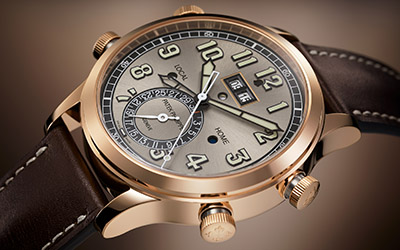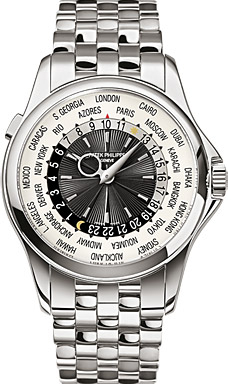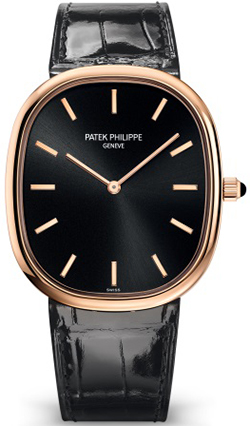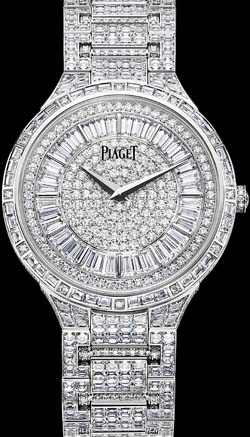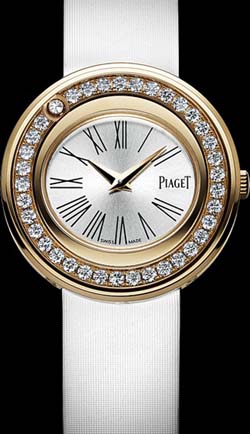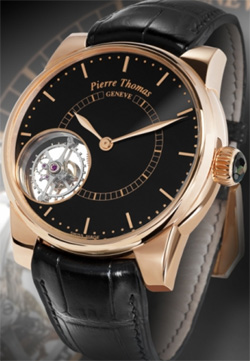
World's 1200 Top Watch Brands & Watchmakers: PPATEK PHILIPPE & Co. (PP) is a Swiss luxury watch manufacturer founded in 1851, located in Geneva and the Vallée de Joux. It designs and manufactures timepieces and movements including some of the most complicated mechanical watches. Polish watchmaker Antoni Patek started making pocket watches in 1839 in Geneva, along with his fellow Polish migrant Franciszek Czapek. They separated in 1844, and in 1845 Patek joined with the French watchmaker Adrien Philippe, inventor of the keyless winding mechanism. Patek Philippe & Co was founded in 1851. Patek Philippe pioneered the perpetual calendar, split-seconds hand, chronograph, and minute repeater in watches. Like other Swiss manufacturers, the company produces mostly mechanical movements of the automatic and manual wind variety, but has produced quartz watches in the past, and a digital wrist watch, the Ref. 3414. Patek Philippe is notable for manufacturing its own watch components. Patek Philippe timepieces have recorded high prices in auctions worldwide. A large part of the demand for auction pieces is driven by Patek Philippe themselves, as they are often purchasing in the auction market to add to the collection of the Patek Philippe Museum in Geneva. In 2010, the company produced 40,000 watches. The company has been owned by the Stern family since 1932, and, as of the late 2000s, led by Philippe Stern and his son Thierry Stern. Patek Philippe produced an ultra-complicated (with 24 functions) pocket-watch for Henry Graves, Jr., who entered into a friendly horological competition with James Ward Packard, which resulted in the production of the watch (known as "The Supercomplication") sold to Mr. Graves in 1933. After his death, the watch was auctioned at Sotheby's in December 1999 for USD$11,000,000, at that time the most expensive timepiece ever sold. On April 10, 2008, "Ref. 5002P Sky Moon Tourbillon" a platinum Patek Philippe tourbillon wristwatch made the world record as the most expensive modern wristwatch sold at Hong Kong Sotheby's for HK$11.75 million ($1.49 million US). The previous record was held by a Vacheron Constantin Tour de l'Ile wristwatch, which sold at Antiquorum for $1.4 million in Geneva in 2005. On May 10, 2010, a Patek Philippe wristwatch became the most expensive to be sold at auction when purchased by a Swiss museum, through Christie's in Geneva, for 6.26 million Swiss francs ($5.50 million US). The chronograph wristwatch, from yellow gold, has a perpetual calendar and moonphase display, and was produced in 1943 in the Geneva manufacture of Patek Philippe. The PEBBlE E-PAPER WATCH is an upcoming smartwatch developed by Pebble Technology that was funded by raising money via the crowdfunding platform Kickstarter. After raising venture capital for the product under their former name inPulse, the company failed to attract traditional investors under their new brand name, so the company requested crowdfunding in April 2012. At the end of the funding, Pebble became the most highly funded Kickstarter project to date with $10,266,844 pledged by 68,928 people. In a press conference at CES 2013 on January 9, 2013, CEO Eric Migicovsky announced that the first Pebbles will ship on January 23, 2013 with 15,000 watches being produced and shipped every week. The Pebble E-Paper Watch was designed based on a concept from Eric Migicovsky, of a watch that can display messages from a smartphone. The Pebble E-Paper Watch is reported to have a 1.26-inch 144 × 168 pixel monochrome LCD display with backlight, a vibrating motor, a magnetometer, ambient light sensors and a three-axis accelerometer. It will communicate with an Android or iOS device using Bluetooth 2.1 but includes support for Bluetooth 4.0 (Bluetooth Low Energy) for a later update when more phones support it. The battery was reported in April 2012 to last seven days. Based on feedback from Kickstarter backers, the developers have added water-resistance to the list of features. The watch will be charged using a modified USB-cable that attaches magnetically to the watch to ensure the waterproofing. The Pebble will come with apps pre-installed, including a cycling app to measure speed, distance and pace through GPS, and a golf rangefinder app that supports more than 25,000 courses. More apps will be downloadable from the phone, and an SDK will be freely available. Not all apps will be installed when the watch ships but CEO Eric Migicovsky announced on January 9, 2013 that there will be updates for the watch's OS (which is based on FreeRTOS) every 2-3 weeks until all features are added. Pebble will integrate with the web service IFTTT which will allow users to create rules for event that will sent notifications to the watch. Abraham-Louis PERRELET, born in Neuchâtel in Switzerland was a Swiss horologist. Perrelet invented a self-winding mechanism in 1770s for pocket watches. It worked on the same principle as a modern wristwatch, and was designed to wind as the owner walked, using an oscillating weight inside the large watch that moved up and down. The Geneva Society of Arts reported in 1777 that fifteen minutes walking was necessary to wind the watch sufficiently for eight days, and the following year reported that it was selling well. Perrelet is thus widely acknowledged as the inventor of the basic movement known as 'automatic' today. This hypothesis has been recently challenged, as we do not know precisely what was the movement he created. It was pointed out that the first drawing and accurate description of an automatic watch has been created in 1778 by the watchmaker Hubert Sarton fr:Hubert Sarton and that we cannot be sure that the Perrelet watch was actually based on a rotor principle (some others watch makers are also known to have created automatic watches in the 1770s). In 1780 Perrelet created the first pedometer, measuring the steps and distance while walking. While the factory claims to have been in continuous production since the late eighteenth century, the brand has only recently begun to command attention worthy of its heritage. The brand, acquired in 2004 by Miguel Rodriguez of the Festina Group, has recently (2007) appointed Marc Bernhardt as CEO of Perrelet, and under his direction the company has released a few highly regarded watches. These include watches with retrograde, jumping hour, and double-rotor complications. In terms of pricing, Bernhardt has positioned Perrelet in the lower middle of the luxury market, with most of their recent releases priced between five and ten thousand (US) dollars. Their upper-range watches featuring costlier complications, such as tourbillons or minute-repeaters, typically retail in the thirty to forty thousand (US) dollar range. In 2009 Rodriguez appointed Fausto Salvi as CEO of Perrelet. Perrelet sold some of his watches to a contemporary watch making luminary, Abraham-Louis Breguet around 1780 who improved upon the mechanism in his own version of the design, calling his watches "perpetuelles" the French word for perpetual. They did not work reliably and Breguet stopped producing them around 1800. PIAGET SA is a Swiss luxury watchmakers and jewellers, founded in 1874 by Georges Piaget in the village of La Côte-aux-Fées. The company belongs to the Swiss Richemont group, specialists in the luxury goods industry. The company was founded as a manufacturer of watch movements but began marketing its own line of prestigious watches in the 20th century. In 2008, The Luxury Institute jewellery brand study ranked Piaget as the 6th most prestigious jewellery brand. In 1874, Georges Edouard Piaget set up his first workshop on the family farm, situated in the small village of La Côte-aux-Fées in the Swiss Jura mountains. Situated in the Neuchâtel region, the company was dedicated to crafting pocket watches and high-precision clock movements for prestigious brands. In 1911, Timothée Piaget, the son of Georges Piaget, took over the family firm. The company's policy has been to be dedicated to the production of wrist watches ever since. Under the guidance of the founder’s grandsons, Gérald and Valentin Piaget, the Piaget brand became a registered trademark in 1943. Since then, the Manufacture at La Côte-aux-Fées has produced its own creations and has undergone international expansion. As a result of this expansion, the family business opened a new factory in 1945, again in La Côte-aux-Fées. In 1957, the manufacture at La Côte-aux-Fées brought out the Calibre 9P, the first ultra-thin (2 mm), hand-wound mechanical movement. Then, in 1960, the Piaget watchmakers developed the Calibre12P, the thinnest automatic movement in the world with a thickness of 2.3 mm (made official by an entry in the Guinness Book of Records). The Piaget collection was diversifying. In addition to coin watches, ring watches, brooch watches and cufflink watches, Piaget created their first pieces of jewellery. In 1957, the Emperador men’s watch was launched and since it's relaunch in 1999 become one of the brand’s emblematic models. The company’s expansion led to the opening of a new factory in Geneva, dedicated to jewellery and, in 1959, their first boutique. In 1964, Piaget presented their first watches with dials worked in precious stones: lapis-lazuli, turquoise, onyx and tiger's eye. Piaget then launched the cuff watch, which became a symbol of fine watchmaking. 1976 saw the launch of the Calibre 7P, a quartz movement. The Piaget Polo watch with its avant-garde style, was brought out in 1979 and became one of the brand’s iconic models. The Dancer collection, launched in 1986, met with similar success.Under the presidency of Yves Piaget since 1980, Piaget have continued to cultivate the status of "watchmaker-jeweller". The luxury Vendôme group, now Richemont, purchased the Piaget Manufacture in 1988. In 2004, Piaget celebrated the 130th anniversary of their creation. The PEBBLE WATCH is a smartwatch developed by Pebble Technology and released in 2013 that was funded by raising money via the crowd funding platform Kickstarter. At the end of the funding, Pebble became the second most highly crowd-funded project to date with US$10,266,844 pledged by 68,928 people. The watch has a 1.26-inch 144 × 168 pixel black and white ultra low power "memory LCD" made by Sharp (described as "ePaper") with backlight, a vibrating motor, a magnetometer, ambient light sensors and a three-axis accelerometer. It will communicate with an Android or iOS device using Bluetooth 2.1 but includes support for Bluetooth 4.0 (Bluetooth Low Energy) for a later update when more phones support it. The battery was reported in April 2012 to last seven days. Based on feedback from Kickstarter backers, the developers added water-resistance to the list of features. The watch is charged using a modified USB-cable that attaches magnetically to the watch so as not to compromise water resistance. The Pebble was slated to ship with apps pre-installed, including a cycling app to measure speed, distance and pace through GPS, and a golf rangefinder app that supports more than 25,000 courses. These apps use data received from a connected phone for distance, speed and range information. More apps will be downloadable from the phone, and an SDK will be freely available.
Browse watch brands & makers: A-ZA B C D E F G H I J K L M N O P Q R S T U V W X Y Z - P -

|
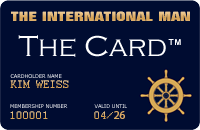
Upcoming VIP Privilege Membership Card
The International Man will in the near future be launching its own PRIVILEGE & BENEFIT VIP MEMBERSHIP CARD - named simply 'The Card'. Members will receive special privileges, benefits and preferential rates with selected partner hotels, restaurants, our LUXURY WEBSHOP, and more. Enter your name and e-mail address to receive FREE INFO about 'The Card' HERE.












